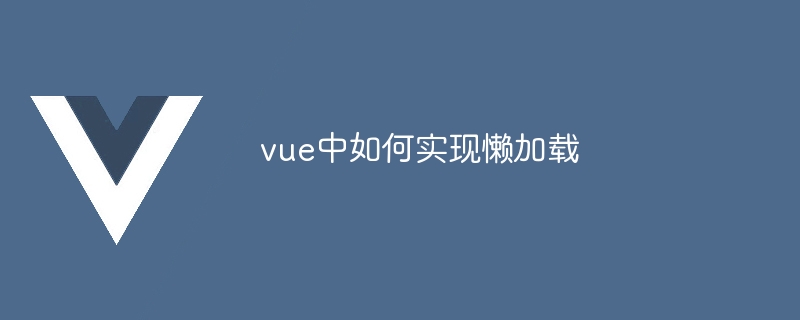How to implement lazy loading in vue
Lazy loading is a technique that allows resources to be loaded when needed. In Vue, you can use the v-lazy directive to implement lazy loading, which allows you to specify that resources should only be loaded when the element enters the viewport. By installing the Vue Lazyload plugin, registering the plugin, and using the v-lazy directive, you can customize various options, such as placeholder images and retries, to suit your specific needs.

Implementing lazy loading in Vue
What is lazy loading?
Lazy loading is a technique that allows resources to be loaded when needed, rather than loading them at the beginning. This helps reduce page load times, especially for pages that contain a lot of resources like images or videos.
How to implement lazy loading in Vue?
Vue can use the built-in v-lazy directive to implement lazy loading. This directive allows you to specify that the resource should only be loaded when the element enters the viewport.
Steps:
- Install the Vue Lazyload plug-in:
npm install vue-lazyload --save
- Register the plugin in the Vue instance:
import Vue from 'vue' import VueLazyload from 'vue-lazyload' Vue.use(VueLazyload)
- Use the
v-lazydirective on elements that need to be loaded lazily:
<img v-lazy="imageUrl" />
where imageUrl is the URL of the image to be lazy loaded.
Customization options:
In addition to the v-lazy directive, the Vue Lazyload plug-in also provides the following customization options:
loading: Specifies the URL of the placeholder image being loaded.error: Specifies the URL of the placeholder image if the resource fails to load.throttle: Set the number of milliseconds to wait before the scroll event fires.attempt: Set the number of attempts to load the resource before giving up.
Example:
<template>
<div>
<img v-lazy="imageUrl" loading="/loading.gif" error="/error.png" />
</div>
</template>
<script>
export default {
data() {
return {
imageUrl: 'https://example.com/image.jpg'
}
}
}
</script>With these steps, you can easily implement lazy loading in Vue to improve page performance.
The above is the detailed content of How to implement lazy loading in vue. For more information, please follow other related articles on the PHP Chinese website!

Hot AI Tools

Undresser.AI Undress
AI-powered app for creating realistic nude photos

AI Clothes Remover
Online AI tool for removing clothes from photos.

Undress AI Tool
Undress images for free

Clothoff.io
AI clothes remover

Video Face Swap
Swap faces in any video effortlessly with our completely free AI face swap tool!

Hot Article

Hot Tools

Notepad++7.3.1
Easy-to-use and free code editor

SublimeText3 Chinese version
Chinese version, very easy to use

Zend Studio 13.0.1
Powerful PHP integrated development environment

Dreamweaver CS6
Visual web development tools

SublimeText3 Mac version
God-level code editing software (SublimeText3)

Hot Topics
 1664
1664
 14
14
 1423
1423
 52
52
 1318
1318
 25
25
 1269
1269
 29
29
 1248
1248
 24
24
 How to use bootstrap in vue
Apr 07, 2025 pm 11:33 PM
How to use bootstrap in vue
Apr 07, 2025 pm 11:33 PM
Using Bootstrap in Vue.js is divided into five steps: Install Bootstrap. Import Bootstrap in main.js. Use the Bootstrap component directly in the template. Optional: Custom style. Optional: Use plug-ins.
 How to add functions to buttons for vue
Apr 08, 2025 am 08:51 AM
How to add functions to buttons for vue
Apr 08, 2025 am 08:51 AM
You can add a function to the Vue button by binding the button in the HTML template to a method. Define the method and write function logic in the Vue instance.
 How to use watch in vue
Apr 07, 2025 pm 11:36 PM
How to use watch in vue
Apr 07, 2025 pm 11:36 PM
The watch option in Vue.js allows developers to listen for changes in specific data. When the data changes, watch triggers a callback function to perform update views or other tasks. Its configuration options include immediate, which specifies whether to execute a callback immediately, and deep, which specifies whether to recursively listen to changes to objects or arrays.
 How to return to previous page by vue
Apr 07, 2025 pm 11:30 PM
How to return to previous page by vue
Apr 07, 2025 pm 11:30 PM
Vue.js has four methods to return to the previous page: $router.go(-1)$router.back() uses <router-link to="/" component window.history.back(), and the method selection depends on the scene.
 What does vue multi-page development mean?
Apr 07, 2025 pm 11:57 PM
What does vue multi-page development mean?
Apr 07, 2025 pm 11:57 PM
Vue multi-page development is a way to build applications using the Vue.js framework, where the application is divided into separate pages: Code Maintenance: Splitting the application into multiple pages can make the code easier to manage and maintain. Modularity: Each page can be used as a separate module for easy reuse and replacement. Simple routing: Navigation between pages can be managed through simple routing configuration. SEO Optimization: Each page has its own URL, which helps SEO.
 React vs. Vue: Which Framework Does Netflix Use?
Apr 14, 2025 am 12:19 AM
React vs. Vue: Which Framework Does Netflix Use?
Apr 14, 2025 am 12:19 AM
Netflixusesacustomframeworkcalled"Gibbon"builtonReact,notReactorVuedirectly.1)TeamExperience:Choosebasedonfamiliarity.2)ProjectComplexity:Vueforsimplerprojects,Reactforcomplexones.3)CustomizationNeeds:Reactoffersmoreflexibility.4)Ecosystema
 How to reference js file with vue.js
Apr 07, 2025 pm 11:27 PM
How to reference js file with vue.js
Apr 07, 2025 pm 11:27 PM
There are three ways to refer to JS files in Vue.js: directly specify the path using the <script> tag;; dynamic import using the mounted() lifecycle hook; and importing through the Vuex state management library.
 How to jump to the div of vue
Apr 08, 2025 am 09:18 AM
How to jump to the div of vue
Apr 08, 2025 am 09:18 AM
There are two ways to jump div elements in Vue: use Vue Router and add router-link component. Add the @click event listener and call this.$router.push() method to jump.




